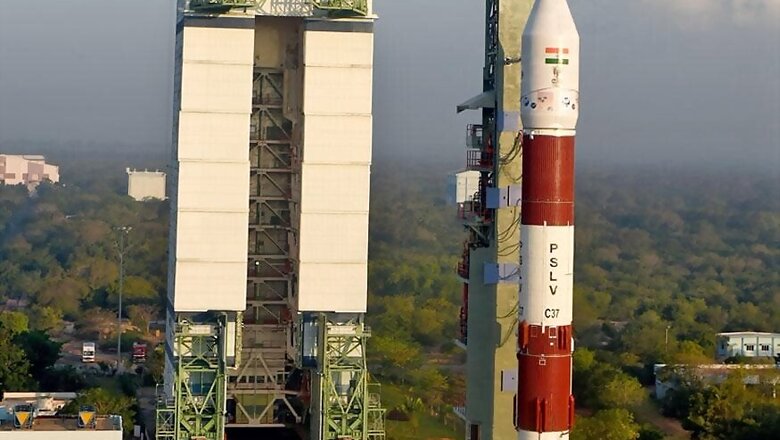
views
The year 2017 could be said to be one of the mixed fortunes for the Indian space agency as it launched the much-awaited four-tonne rocket Geosynchronous Satellite Launch Vehicle-Mk III (GSLV-Mk III); put into orbit 104 satellites in a single mission; sent up the South Asia Satellite; and also crossed the double century mark of launching foreign satellites.
With the size of earth observation satellites reducing and the future trend moving towards a constellation of small satellites rather than a large one, India's space agency is developing a smaller rocket that can carry satellites weighing up to 500 kg. But on the negative side, India's long-due satellite navigation system (NavIC) faced serious problems with the atomic clocks in a couple of satellites developing problems.
The clocks are important to provide precise locational data. The mission to put into orbit a replacement for the first of the seven navigation satellites didn't succeed as the lighter Polar Satellite Launch Vehicle (PSLV) failed in its mission. The year also saw India taking steps towards opening up the sector for private players as the government sought comments on its Draft Space Activities, Bill.
The Indian Space Research Organisation (ISRO) had a great start with a record satellite launch and good going for the major part of the year but wound up 2017 smarting after an unexpected disaster. In February India set a world record in the number of satellites launched in a single mission by successfully putting into orbit 104 satellites, including the country's own Cartosat-2 earth observation satellite.
This was followed by the copy book-style launch of the South Asia Satellite, intended to serve "economic and developmental priorities" of South Asian nations, using its heavier GSLV-Mk II rocket. In 2014, Prime Minister Narendra Modi tasked ISRO to develop a satellite for use by the SAARC countries. But Pakistan declined the use of an India-developed satellite.
One of the unique aspects of the South Asia Satellite is that ISRO decided to have electric power for it -- without cutting down on the volume of traditional onboard fuel -- to check its performance for use in future satellites. In May, India scored a double success, launching its latest -- and heaviest so far -- 3,136 kg GSAT-19 communication satellite with its brand new and heaviest GSLV-Mk III with a cryogenic engine.
While Indian space scientists named the 640-tonne rocket "fat boy", the Telugu media nicknamed it "Bahubali" as, like the hero in the massively successful film lifts a heavy Lingam, it carried the heaviest satellite by an Indian rocket. The month of June saw ISRO completing yet another multiple satellite launch, putting into orbit the Cartosat satellite, Nanosatellite NIUSAT and 29 foreign satellites from 14 countries.
In the process, ISRO crossed the double century mark in launching foreign satellites. India started launching foreign satellites in 1999. The June month also saw India adding GSAT-17 to its fleet of communication satellites after it was launched into orbit by the heavy-lift rocket Ariane 5 from Kourou in French Guiana. And there ended the tale of ISRO's success for 2017.
The last day of August turned out to be a black Thursday for ISRO as it suffered a serious setback after its PSLV rocket failed to deliver India's navigation satellite in its intended orbit. The 1,425 kg Indian Regional Navigation Satellite-1H (IRNSS-1H), got stuck inside the rocket's upper deck as the heat shield did not separate to let it out. "The rocket heat shield didn't separate. The satellite is inside the heat shield," ISRO Chairman A.S. Kiran Kumar said.
"The PSLV rocket has been successful for the past several years. So, the question of design failure does not arise. It could be an issue of a failed component or a process quality issue," M.Y.S. Prasad, a former Director of the Satish Dhawan Space Centre, told IANS. While the Failure Analysis Committee (FAC) is yet to come out with its report on the cause of PSLV's failure, K. Sivan, Director, Vikram Sarabhai Space Centre, told IANS that failure of the pyro elements could be the reason for the non-separation of the heat shield.
Normally, the heat shield would separate from onboard computers give the command to ignite the explosives. The explosives would then ignite and explode to separate the two parts of the heat shield joined by bolts. He said ISRO is further tightening the allowable dispersion, or variance from the ideal performance parameter, for all the systems in the PSLV. Meanwhile, Sivan said the preliminary design for the proposed small four-stage rocket that would weigh around 100 tonnes is ready and its feasibility study has also been conducted.
The first rocket would be ready in two years once the project gets the necessary approvals, he added. The PSLV rocket has three variants weighing between 230 tonnes and 320 tonnes, with a carrying capacity ranging between 1,100 kg and 1,900 kg. Looking forward to 2018, Sivan said it is going to be an eventful year with several launches, including the country's second Chandrayaan moon mission.
Sivan said ISRO will be launching a Cartosat satellite and several foreign satellites as piggy-back with the PSLV rocket sometime in January 2018. He said the country's heaviest communication satellite -- the GSAT 11, weighing over five tonnes -- would be launched next year by Arianespace's Ariane rocket.
2017: Indian space scene in capsule
* Enforcement Directorate (ED) attached Rs.79.76 crore funds of Devas Multimedia Ltd under the Prevention of Money Laundering Act (PMLA) for its alleged illegal deal with ISRO's commercial arm Antrix Corporation
* Renowned Indian space scientist U.R. Rao passed away aged 85
* Launched four-ton capacity rocket GSLV-Mk III
* Put into orbit South Asia Satellite
* PSLV rocket failed to launch navigation satellite
* Three atomic clocks in first navigation satellite failed
Watch: Tech and Auto Show | Ep 24 | Honor 7X, TVS Apache RR 310, Volvo XC60 & More



















Comments
0 comment